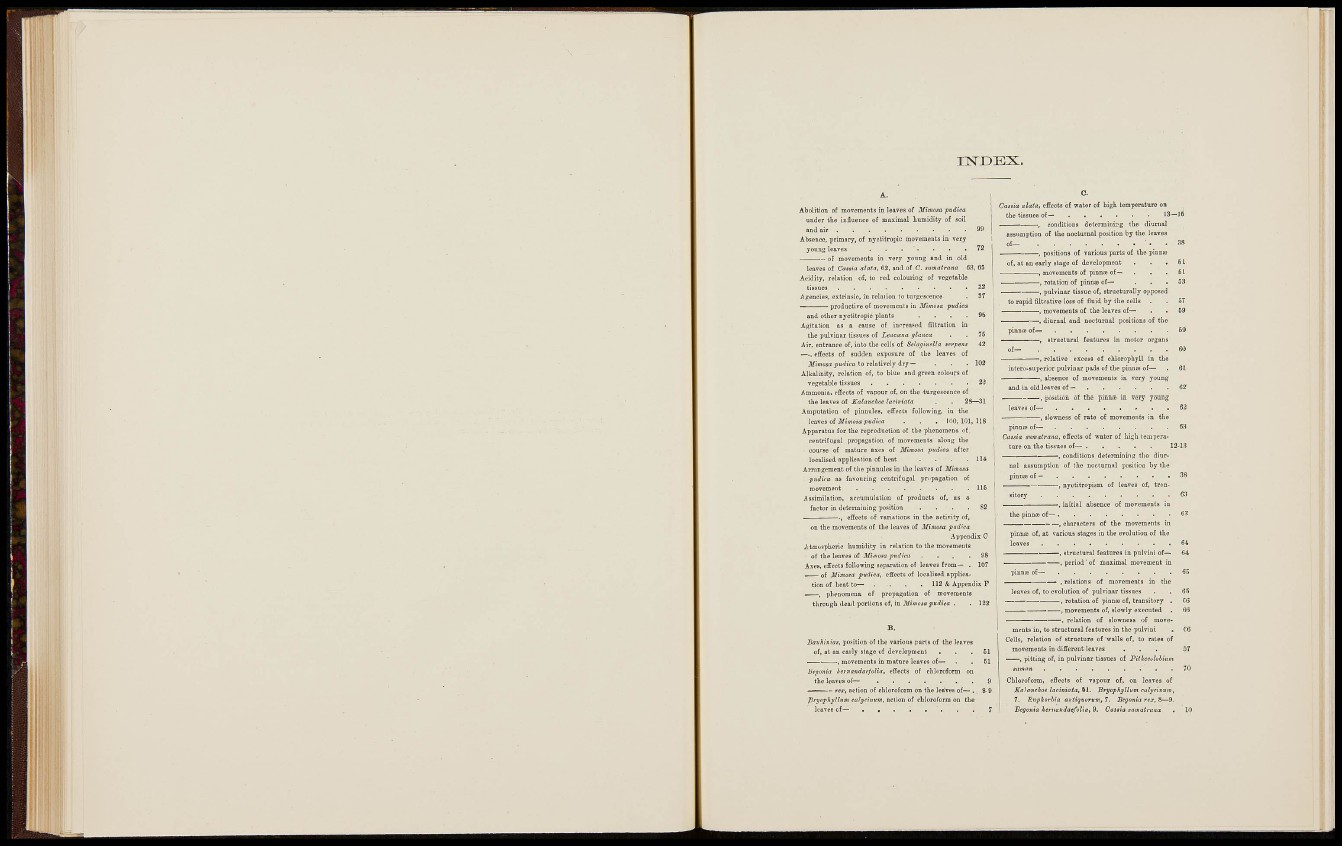
I N D E X .
Abolition of moTomonts in leaves of Mimosa padica
QQder the influence of maximal humidity of soil
Castia alata, effects of water of High
the tissues o f -
Absoneo, piimory, of nyetifcropio moTements in very
young leaves . . . •
of movements In Tory young and in old
leaves of Cassia alata, 62, and of C. sumalrana 63,
Acidity, relation of, to red colouring of vegetable
Agencies, extrinsic, in relaiiou to turgescence . S7
product!re of moTcments in Mimosa pudica
and other nyctitropio plants . . . . 95
Agitation as a cause of iiirrcased filtration in
the pulvinar tissues of XenciBna jZoKca . . 75
Air, entrance of, into the cells of Selaginella serpens 42
—. effects of sudden exposure of the leaves of
to relatively dry— . . .102
Alkalinity, relation of, to bluo and green colours of 1
vegetable tissue i
Ammonia, effects of vapour of. on the turgcscence of
the leaves of Kalanchoe laciniala . . 2S—31
Amputation of pinnules, cfiects following, in the '
Uarei o( MimosapudUa . . ino,101, 118
Apparatus for the reproduction of the phenomena of [
centrifugal propagation of movements along the
course of mature axes of MinioS'i pudica after
localised application of heat . . , l U [
Arrangement of tlie pinnules in the leaves of Mimosa
pviira as favouring centrifugal pr.pagation of
movemont 116
Assimilai ion, accuniulalion of products of, as b
factor in determining position . . . . 82
-, cftcc^ts of variations in the activity of,
on the movements of the leaves of Mimosa pudica
Appendix C
Atmospheric humidity in relation to the movemeuts
of the leaves of Mimosa pudica . . . .98
Axes, effccts following separation of leaves from— . 107
— of J/imoio pudica, effccts of localised application
of heat to— . . . . 112 & Appendix P
, phenomena of propagation of movements
through dead portions of, in jViimoiapwrfiia . . 122
Sauhinias, position of iho various ports of the leave
of, at an early stage of development .
movements in mats re leaves of—
tieponia hernandatfoUa, effects of chloroform
the lonves of—
— r e x , action of cliloroform on the leaves of—
JJrycfhyilum caiycinum, action of chloroform on the
leaves o f -
lS-16
conditions detorminirg the diurnal
imption of the nooturnal position by the leaves
of, at an early stage of development
of pinnje of—
-, rotation of pinnaj of—
-, pulvinar tissue of, structurally opposed
to rapid filtrati ve loss of fluid by the cells .
, movements of the loaves of—
— —, diurnal and nocturnal positions of the
pinna) of— . . . . . . . .
, structural features in motor organs
.relative excess of chlorophyll in the
intero-superior pulvinar pads of the pinn» of—
, absence of movements in very young
and in old leaves of—
, position of the pinuio in very young
leaves of—
, slowness of rate of movements in the
p i ™ » ' - • •
Cassia siimatrana, effects of water of high tempera-
•a the ti
s determining the diut
nal assumption of the nocturnal position by the
— , nyctitropism of leaves of, tren-
-, initial absence of movements i
pinnte of, at various stages in the evolalion of the
leaves 64
-, structural features in pulvini of— 64
, period of masittial movement i;
— •— , relations of :
leaves of, lo evolution of pulvii
— • 1 rotation of pinn» of, transitory .
, movements of, slowly executed .
relation of slowness of movements
in, to structural features in the pulvini .
Cells, relation of structure of walls of, to rates of
movements in different leaves . . .
. pitting of, in pulvinar tissues of Pithecalohium
Chloroform, effccts of vapour of, on leaves of
Kalanthoe laciniata, 61. STyophyllum calscinum,
7. ivphorlia aniiquoram, 1. Scgonia rex, 8—9.
Begonia hernandaefolia, 9. Catsia sumalruna ,